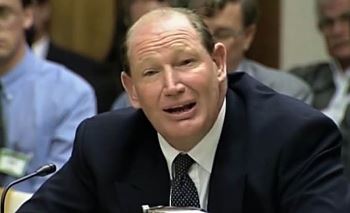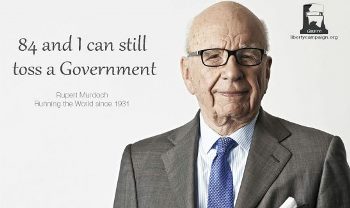|
The Death of Investigative Journalism in Oz, Channel Nine’s Takeover of Fairfax
by Binoy Kampmark via stacey - Global Research Wednesday, Aug 1 2018, 8:43pm
international /
prose /
post
Media moguls Murdoch and Packer are responsible for the outrageously concentrated media that exists today in Australia, nevertheless, the last bastion of real investigative journalism, the Fairfax owned outlets, survived the onslaught for a time, today however Fairfax has succumbed to popularity, goodbye informative reporting and hello populist, meaningless media. Tit and sensationalism is how Murdoch built his global empire and as verified by the takeover company, money is now the number one consideration.
What this takeover (merger is a misnomer) represents is the cultural failing of a nation, which has all but lost its unique identity to toxic American values, the nation which is now a suitable home for Murdoch and his toxic, sensationalist media.

Kerry Packer, former owner channel 9 now deceased, mocking Senators at government inquiry
The idea that Australia’s Channel Nine network should be consuming the longstanding press entity that is Fairfax Media in an incongruous commercial merger raises a similarly awkward question. Not that Channel Nine doesn’t do journalism. It does, just of a frightful, ambulance chasing sort.
The deal would see the creation of a media behemoth in what is already one of the world’s most concentrated media landscapes. Nine’s free-to-air television network would be linked with the ongoing concern of Fairfax’s The Age and The Sydney Morning Herald, its radio assets (Sydney’s 2GB and Melbourne’s 3AW), the streaming video platform Stan and the real estate portal Domain.
Reassurances given about the continued independence and quality of that press entity are meaningless. Nine chief executive Hugh Marks is undeterred. “We just needed to reassure the creators and journalists that their world wasn’t going to change. It’s all about how a bigger scale company can take their work and generate more revenue.”
Marks, in slanting the emphasis towards generating revenue, ignores the actual practice of meaningful, investigative journalism. Head entities with the dominant running concern have a habit of heaping their values upon subordinates. Cross-pollination, of the more sordid kind, is bound to happen, and it is the very sort that is bound to be lethal to a certain species of effective scribbling.
The marketing fraternity simply see promotions and deals, the empty hum that comes with entertainment platforms. Former Australian treasurer Peter Costello and Nine Entertainment chairman advances the most crude of corporate lines: “This is the opportunity to build a media company for the digital age, growing revenue with complementary streams and in a position to create growth opportunities for both sets of shareholders.”
Forget the informative, hard-hitting journalism; this is brand appeal, an issue centred on “data solutions”, “premium content” and stock value. The role of the Fourth Estate here is singularly less important than that of the commercial estate, of which Nine has been inhabiting with some discomfort of late.
David Waller of the University of Sydney sees the prospects of cross promotion. “By combining different media – TV, print and online – they’ve got a greater scope to get more people to see the message.” He further sees the emergence of various hybrid progeny: existing stars will branch out; day time television specialists may find their way into radio, and radio shock jocks into television. It does not seem to bother Waller that quality might well be the most conspicuous casualty.
Australia’s media and press landscape has had a problem with diversity for years, stuck in concentrated monochrome. Even praise for Fairfax has to be qualified. While there are excellent pockets of striving reporters with tenacious burrowing skills, there are the recyclers and the plodders. “For the most part,” notes Stephen Harrington of the Queensland University of Technology, “we have seen a real evacuation of hard-hitting political journalism from TV in the last 20 years or so.
Such a merger supplies another crude nail to the coffin of Fourth Estate activities. The state’s democratic health, opines former Fairfax journalist Andrea Carson, “relies on more than a A$4 billion merger that delivers video streaming services like Stan, a lucrative real estate advertising website like Domain, and a high-rating television program like Love Island.”
Former Australian Prime Minister Paul Keating, in giving the proposed merger a generous rubbishing, was sharper than ever about the implications. Channel Nine, he warned, had “never other than displayed the opportunism and ethics of an alley cat.”
Had Australia a viable, operable protection of free speech enshrined in its constitution (it has, as it were, an anaemic variant called an implied right to communication on political subjects), such a merger would be legally damned as an affront that would actually restrict rather than expand discussion on public interest matters affecting the country. But such issues ride poorly in such quarters as that of Channel Nine, where what is supposedly interesting to the public has preferment over what is in the public interest.
In light of this merger, gritty, informed reporting can go hang, and those unwilling to go along with the management line are bound to either adapt or leave the arena. The focus will be on other papers and outlets, those considered resolute outliers, to gather the principled survivors.
The optimist may venture another less likely prediction: that Fairfax’s investigative vigour might find its way into Nine’s moribund programs that qualify as foot-in-the-door journalism. Imagine 60 Minutes moving beyond lamentable gossip and suburban rumour? Or the content skimpy A Current Affair adjusting from bread-and-circuses horror stories of entertainment to matters of intellectual substance? All terribly unlikely, but some will dare to dream.
Copyright applies.

Rupert Murdoch, nothing has changed today
https://www.globalresearch.ca/the-death-of-investigative-journalism-australias-channel-nines-takeover-of-fairfax/5649311
<< back to stories
|